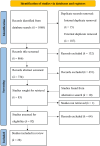Psychometric properties of the Spousal Assault Risk Assessment from samples of people having perpetrated intimate partner violence
- PMID: 39044383
- PMCID: PMC11545129
- DOI: 10.1177/15248380241262275
Psychometric properties of the Spousal Assault Risk Assessment from samples of people having perpetrated intimate partner violence
Abstract
Since it was first published in 1995, the Spousal Assault Risk Assessment (SARA) Guide has become one of the most used and researched intimate partner violence (IPV) risk measures worldwide. Yet, no recent review has formally and systematically established the psychometric properties of this measure. Furthermore, the third version of the SARA (SARA-V3) was published in 2015, with no psychometric critique to date. This review aimed to provide an inclusive and exhaustive literature review of all psychometric properties (i.e., predictive validity, convergent validity, internal consistency, and inter-rater) of the SARA, including V3. A systematic search of 17 databases was conducted following Preferred Reporting Items for Systematic Reviews and Meta-Analysis (PRISMA) guidelines. Academic journals, book chapters, and gray literature were included but conference presentations were not. To be included studies had to report a psychometric property of any version of the SARA and be composed of individuals having committed IPV. The search identified 28 records published between 1997 and 2022. Results showed that although the literature on the SARA is mostly positive, it is much more varied in terms of both results and research quality than its widespread implementation might suggest. Most studies were conducted using case files in a research context with non-diverse samples, undermining ecological validity. Results for convergent and predictive validity were mostly positive. However, reliability statistics were under-researched and showed poorer results. Lastly, little research has gone into validating the SARA-V3, with what is available suggesting poorer reliability and validity than its predecessor. Practitioners are cautioned against transitioning to the newer version before further validation research has occurred.
Keywords: assessment; domestic violence; predicting domestic violence.
Conflict of interest statement
Declaration of Conflicting InterestsThe author(s) declared no potential conflicts of interest with respect to the research, authorship, and/or publication of this article.
Figures
References
-
- *Andres-Pueyo A., Lopez S., Alvarez E. (2008). Valoración del riesgo de violencia contra la pareja por medio de la sara SARA [Assessment of the risk of intimate partner violence and the SARA]. Papeles Del Psicologo, 29(1), 107–122.
-
- *Arbach K., Folino J. (2021). La Valoración del riesgo de reincidencia en imputados por violencia contra la pareja: Un estudio longitudinal con la guía SARA [Risk assessment of intimate partner violent reoffending: A longitudinal study with the Spousal Assault Risk Assessment guide]. Anuario de Psicología Jurídica, 31(1), 35–44.
-
- Beaupré P. (2015). Causes réglées par les tribunaux de juridiction criminelle pour adultes relatives à la violence entre partenaires intimes. In Centre canadien de la statistique juridique (Eds.). La violence familiale au Canada: Un profil statistique, Juristat, 35(1), 85-002-X.
-
- *Belfrage H., Strand S., Storey J. E., Gibas A. L., Kropp P. R., Hart S. D. (2012). Assessment and management of risk for intimate partner violence by police officers using the spousal assault risk assessment guide. Law and Human Behavior, 36(1), 60–67. - PubMed
-
- Bertrand R., Blais J.-G. (2004). Modèles de Mesures : L’apport de la Théorie des Réponses aux Items. Presses de l’Université du Québec.
Publication types
MeSH terms
LinkOut - more resources
Full Text Sources
Medical


